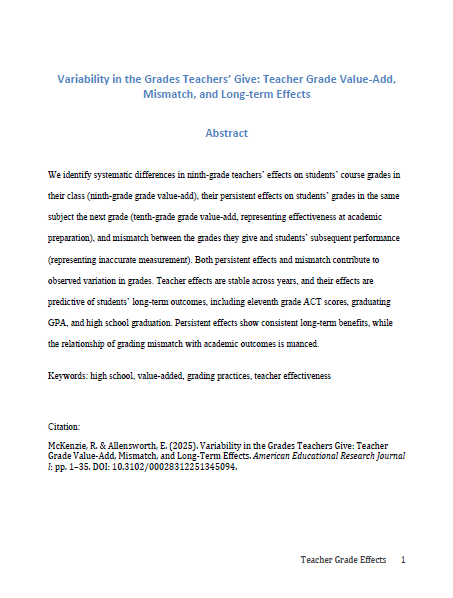1. To what extent do ninth-grade teachers have unique effects on students’ course grades in the class they teach, so that students who have a particular teacher receive different course grades, on average, than students who have other teachers for the same course (holding constant student prior achievement and backgrounds, course and school characteristics)?
2. To what extent do ninth-grade teachers have persistent effects on their students’ grades in the same subject the following year—so that students who have a particular ninth-grade teacher get higher or lower grades in the same subject in the fall of tenth grade, relative to students who had other teachers for that subject in ninth grade (holding constant student prior achievement and backgrounds, course and school characteristics)?
3. To what extent do ninth-grade teachers consistently give grades that mismatch their students’ performance in the same subject in the fall of tenth grade—so that their students perform better or worse the following year than would be expected based on the grades they received from the ninth-grade teacher (holding constant student prior achievement and backgrounds, course and school characteristics)?
4. What is the relationship of students’ ninth-grade grades, credits earned, and attendance with their teachers’ total, persistent, and mismatch grade effects?
5. What are the long-term effects of having a teacher with large persistent grade effects or grading mismatch on the number of AP classes taken in tenth and eleventh grade, eleventh grade ACT score, graduating core GPA, and probability of graduating with a diploma within four years?
We identify systematic differences in ninth-grade teachers’ effects on students’ course grades in their class (ninth-grade grade value-add), their persistent effects on students’ grades in the same subject of the next grade (tenth-grade grade value-add, representing effectiveness at academic preparation), and mismatch between the grades they give and students’ subsequent performance (representing inaccurate measurement). Persistent effects and mismatch contribute to observed variation in grades. Teacher effects are stable across years, and their effects are predictive of students’ long-term outcomes, including eleventh-grade ACT scores, graduating GPA, and high school graduation. Persistent effects show consistent long-term benefits, while the relationship of grading mismatch with academic outcomes is nuanced.
The final, definitive version of this paper has been published in the American Educational Research Journal, 62(3), June 2025 by SAGE Publications Ltd./SAGE Publications, Inc., All rights reserved. © 2025

